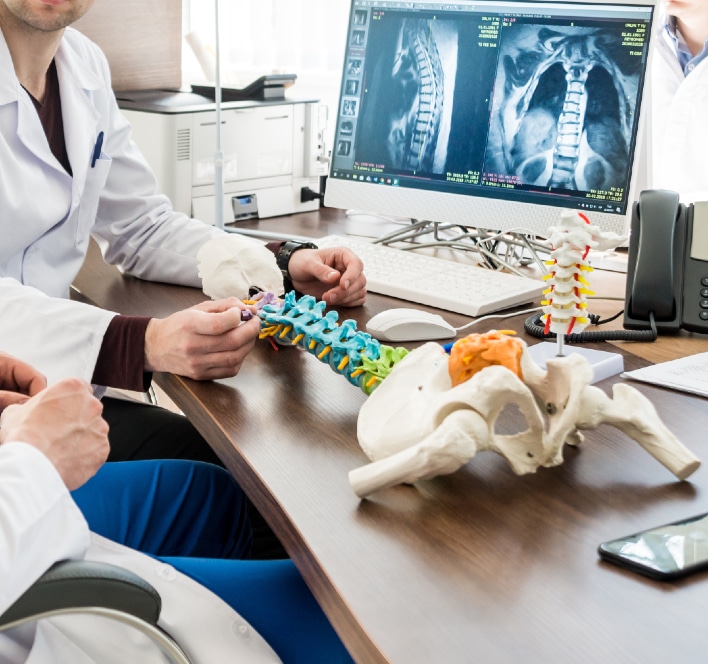Laser spine surgery and microdiscectomy are both minimally invasive procedures utilized to treat spinal conditions. Each offers precision targeting, reduced discomfort, faster recovery, and fewer complications. Laser surgery employs advanced laser technology, providing further precision and reduced post-operative pain. Microdiscectomy boasts high success rates, and a stronger protective layer for muscle tissue. Both carry risks like infection and nerve damage. Choosing between them involves considering surgery costs, insurance coverage, the severity of the condition and personal health factors. With detailed analysis, a clearer understanding emerges to assist the decision-making process. More extensive insights await for further exploration.
Understanding Spinal Conditions
To fully comprehend the distinctions between Laser Spine Surgery and Microdiscectomy, it is essential to first have a thorough understanding of the various spinal conditions that these surgical procedures aim to address. The human spine is a complex, intricate structure that primarily consists of vertebrae, discs, nerves, and muscles. This is the basic understanding of spinal anatomy.
The vertebrae are the bony building blocks of the spine, discs act as shock absorbers between the vertebrae, nerves transmit signals between the body and the brain, and muscles provide movement and support. This harmonious interplay is essential for the spine’s peak function.
However, factors such as aging, injury, or disease can lead to spinal degeneration. This term broadly encapsulates conditions like herniated discs, spinal stenosis, and degenerative disc disease. These conditions can cause significant pain, reduced mobility, and other debilitating symptoms. Understanding spinal degeneration is key to appreciating the role and effectiveness of different surgical interventions, like Laser Spine Surgery and Microdiscectomy.
What Is Laser Spine Surgery?
Laser Spine Surgery, an advanced medical procedure, harnesses the precision of laser technology to treat a myriad of spinal conditions. It is a minimally invasive technique that is employed when traditional surgical methods are deemed unsuitable or risky. This procedure uses different laser types and state-of-the-art surgical equipment to alleviate the discomfort and pain caused by conditions like herniated discs, spinal stenosis, and bone spurs.
The laser types used in spine surgery vary, each offering distinct advantages. Holmium and YAG lasers are the two most commonly used due to their precision and ability to coagulate tissue, reducing bleeding and damage to surrounding structures. The surgical equipment includes the laser system, specialized endoscopes for visualization, and microsurgical tools for dissection and removal of pathologic tissue.
This surgical procedure begins with the surgeon making a small incision, through which the laser and other surgical tools are inserted. Utilizing real-time imaging, the surgeon is able to accurately target the affected area without causing significant damage to the surrounding tissues. Therefore, Laser Spine Surgery presents as an innovative method that offers hope to those battling debilitating spinal conditions.
Benefits of Laser Spine Surgery
With an array of compelling benefits, laser spine surgery has emerged as a potent alternative to traditional surgical methods, providing patients with a minimally invasive, yet highly effective solution for a variety of debilitating spinal conditions. One of the key advantages of this method is the laser precision with which the surgery is performed. This level of accuracy allows surgeons to target the specific area of the spine that is causing pain or discomfort without causing unnecessary damage to the surrounding tissues.
This surgical technique often results in less post-operative pain and faster recovery times, as the surgery itself is less traumatic to the body than traditional open spine surgery. Additionally, laser spine surgery is typically performed as an outpatient procedure, which means patients can return home the same day as their operation, further reducing the overall recovery period.
Furthermore, the use of laser technology minimizes the risk of bleeding and infection, as the laser can coagulate blood vessels during surgery, reducing blood loss and the risk of infection. These benefits combine to make laser spine surgery a viable and effective alternative to traditional surgical approaches for treating a range of spinal conditions.
Potential Risks of Laser Spine Surgery
Despite the numerous advantages of laser spine surgery, it is not devoid of potential risks and complications that should be carefully considered. It is essential to understand these risks to make an informed decision about the surgery.
The potential risks associated with laser spine surgery include:
- Surgery costs: Laser spine surgeries can be expensive, and the financial burden can be substantial. These costs include not only the surgery itself but also related expenses such as medications and rehabilitation.
- Insurance coverage: Not all insurance providers cover laser spine surgery. Patients may face significant out-of-pocket expenses if their insurance does not provide sufficient coverage.
- Complications: As with any surgical procedure, laser spine surgery carries the risk of complications such as infection, nerve damage, and bleeding.
- Limited effectiveness: In some cases, laser spine surgery may not effectively alleviate symptoms, necessitating additional treatments or procedures.
- Recovery time: While recovery from laser spine surgery is usually faster than traditional surgery, some patients may still experience a prolonged recovery period with physical limitations.

Real-Life Case Studies: Laser Spine Surgery
In the pursuit of a thorough understanding of laser spine surgery, it is essential to examine real-life case studies. These instances provide insights into patient experiences and shed light on success rates, offering a tangible means of evaluating this surgical approach. Through the lens of these case studies, we can analyze the efficacy and potential advantages of laser spine surgery.
Patient Experiences: Laser Surgery
Examining real-life case studies provides invaluable insight into the experiences of patients who have chosen laser spine surgery as their preferred treatment option. Laser technology advancements have greatly impacted patient comfort levels during surgery.
- Patient A reported minimal discomfort during the procedure, attributing this to advances in laser technology.
- Patient B, a professional athlete, was back to training within weeks, highlighting the rapid recovery time.
- Patient C, previously dependent on pain medication, found considerable relief post-surgery.
- Patient D experienced increased mobility and a return to daily activities, demonstrating the effectiveness of the surgery.
- Finally, Patient E noted the non-invasive nature of the procedure, appreciating the absence of large surgical incisions.
These real-life cases indicate the potential benefits of opting for laser spine surgery.
Laser Surgery Success Rates
Building on the testimonials from patients who have undergone laser spine surgery, it is essential to further explore the statistical success rates of this innovative procedure to provide a thorough understanding of its efficacy. The evolution of laser technology has led to higher success rates, with one study showing a 70% improvement in patients’ conditions post-surgery. This can be attributed to the precision and minimum invasiveness of laser procedures. Moreover, post-surgery lifestyle changes, such as improved mobility and reduced pain, have greatly increased the quality of life for these patients. However, it’s important to acknowledge that individual outcomes can vary based on factors like the severity of the condition and the patient’s overall health. Thus, a detailed consultation with a specialist is advised before opting for laser spine surgery.
What Is Microdiscectomy?
Microdiscectomy, commonly known as microdecompression, is a surgical procedure used to relieve pressure on a spinal nerve root, often brought on by a herniated lumbar disc. This type of surgery is generally considered when conservative treatments, such as physical therapy and medications, have failed to alleviate the patient’s symptoms.
When deliberating over Microdiscectomy, two important factors that must be considered are the cost of the procedure and the selection of a proficient surgeon.
Key factors include:
- Microdiscectomy costs: The price of a microdiscectomy can vary significantly depending on factors such as the surgeon’s experience, the geographical location, and the complexity of the case.
- Surgeon selection: The surgeon’s expertise and experience play a pivotal role in the success rate of the procedure.
- Pre-operative care: This includes the planning phase, which involves diagnostic tests and evaluations to assess the patient’s overall health and the severity of the disc herniation.
- Procedure: The surgery involves the removal of a small portion of the herniated disc that is pressing on the nerve root.
- Post-operative care: After surgery, the patient’s recovery is monitored closely, and the appropriate rehabilitation program is initiated.
Advantages of Microdiscectomy
Microdiscectomy, a popular surgical procedure for addressing spinal disc herniations, offers a range of benefits that merit careful consideration. Central to these advantages are the recovery process and the success rates which will be the focus of our subsequent discussion. By understanding these aspects, one can gain a thorough perspective on why Microdiscectomy is often chosen as a preferred surgical intervention for disc herniations.
Microdiscectomy Recovery Process
Often praised for its numerous benefits, the recovery process following a microdiscectomy tends to be relatively swift and less strenuous compared to other spine surgeries, offering patients a quicker return to normal activities. This is largely due to the minimally invasive nature of the procedure, which greatly reduces the post-surgery rehabilitation period. Effective pain management techniques can also contribute to a smoother recovery.
Key benefits of the microdiscectomy recovery process include:
– Minimal hospital stay, often allowing patients to return home the same day of surgery.
– Reduced pain and discomfort due to less invasive techniques.
– Lower risk of muscle damage and scarring.
– Faster return to work and regular activities.
– Fewer post-operative complications and lesser need for post-surgery medications.
Success Rates of Microdiscectomy
In evaluating the efficacy of microdiscectomy, it is important to note that this procedure boasts an impressive success rate, effectively alleviating symptoms in approximately 80 to 90 percent of patients. Its high success rate is attributed to the precision with which it targets and treats the affected disc, minimizing damage to surrounding tissue. When considering microdiscectomy costs, it’s beneficial to factor in the high success rate and the potential for reduced long-term healthcare expenses due to effective symptom resolution. Despite the existence of microdiscectomy alternatives, such as laser spine surgery or conservative treatments, the success rates of microdiscectomy provide compelling evidence that it remains a viable and often superior choice for patients suffering from disc-related back pain.
Possible Complications of Microdiscectomy
Despite its high success rates, microdiscectomy surgery is not without potential complications, which can include infection, nerve damage, or recurrent disc herniation. The post-operative care is crucial in mitigating these risks and ensuring a successful recovery. It is important to note that these complications could also greatly impact the overall microdiscectomy cost.
Microdiscectomy complications can be broadly categorized into:
- Infection: Post-operative infection is a risk in any surgical procedure, which can lead to increased recovery time and costs.
- Nerve damage: Although rare, there’s a possibility of nerve damage during the surgery, potentially leading to numbness or weakness in the leg.
- Recurrent disc herniation: There is a chance that the disc herniation could reoccur, necessitating further surgical intervention.
- Dural tear: A tear in the outer layer of the spinal cord, or dura mater, can occur during surgery, leading to a leak of cerebrospinal fluid.
- Blood clots: Post-operative immobility could lead to the formation of blood clots, a potentially life-threatening complication if they migrate to the lungs.
Therefore, understanding potential risks and complications is an essential step in making an informed decision about undergoing microdiscectomy surgery.

Real-Life Case Studies: Microdiscectomy
To further elucidate the complexities and potential outcomes of microdiscectomy surgeries, several real-life case studies offer valuable insights into this medical procedure.
In one case, a 47-year-old patient with severe lumbar disc herniation opted for microdiscectomy after conservative treatments failed to alleviate his pain. A personalized treatment plan was devised, taking into account his lifestyle, occupation, and health status. Post-surgery, the patient reported a significant reduction in pain and improved mobility.
This case underscores the efficacy of microdiscectomy, but it also raises questions about cost. Microdiscectomy cost analysis reveals that this procedure, although highly effective, can be expensive. In the United States, the average cost of a microdiscectomy can range from $20,000 to $50,000, depending on various factors such as hospital fees, surgeon’s fees, and geographical location.
In another case, a 30-year-old professional athlete underwent microdiscectomy. A specialized, aggressive rehabilitation program was included in her personalized treatment plan. Despite the high cost, the surgery was deemed necessary given her career demands. She returned to her sport and achieved previous performance levels within six months.
These cases show the potential benefits of microdiscectomy, but also highlight the need for a thorough cost-benefit analysis in each individual’s unique circumstance.
Comparing Laser Spine Surgery and Microdiscectomy
Drawing a comparison between laser spine surgery and microdiscectomy can further illuminate the potential advantages and drawbacks of each procedure, thereby aiding patients and medical professionals in making informed decisions.
Both surgical approaches target spinal issues, but their techniques, costs, and insurance coverage differ considerably.
- Technique: Laser spine surgery is minimally invasive, utilizing laser technology to treat the spinal issue without substantial damage to surrounding tissue. Microdiscectomy, on the other hand, requires a small incision and the use of traditional surgical instruments.
- Surgery costs: Microdiscectomy, being a traditional surgical method, tends to be less expensive. The advanced technology used in laser surgery often results in higher costs.
- Insurance coverage: While both procedures may be covered by insurance, coverage for laser spine surgery can be limited due to its classification as experimental in some cases.
- Recovery time: Patients undergoing laser spine surgery generally experience quicker recovery times due to the minimally invasive nature of the procedure.
- Risk factors: Although both surgeries carry risks, those associated with laser spine surgery are typically less due to its minimally invasive technique.
The choice between these two procedures will largely depend on individual patient factors, including their specific condition, overall health, and financial capacity.
Making the Right Decision: Factors to Consider
When selecting between laser spine surgery and microdiscectomy, several significant factors should be carefully evaluated to ensure the most beneficial and effective therapeutic approach.
Key among these factors is the cost comparison. Laser spine surgery, being a newer, more technologically advanced procedure, typically commands a higher price tag than traditional microdiscectomy. However, the overall cost will vary depending on the complexity of the case, the surgeon’s experience, and the healthcare facility’s pricing structure. It’s important to obtain a clear, detailed breakdown of all associated costs before making a decision.
Insurance coverage is another crucial factor to consider. Not all insurance companies cover laser spine surgery due to its relatively recent emergence in the medical field. On the other hand, microdiscectomy is a long-established procedure and is typically covered by most insurance plans. It’s necessary to thoroughly review your insurance plan’s coverage and discuss this with your healthcare provider.
Frequently Asked Questions
What Is the Recovery Time for Both Laser Spine Surgery and Microdiscectomy?
The recovery time post-surgery varies depending on individual factors. However, potential complications and effective pain management can influence it. Generally, laser surgery may require a few days, while microdiscectomy could necessitate several weeks of recovery.
Are There Any Lifestyle Modifications or Physical Therapy Required After These Surgeries?
Post-surgery lifestyle modifications often include a balanced diet and exercise limitations to aid recovery. Physical therapy is typically recommended to regain strength and flexibility, while certain activities may be restricted initially to prevent injury.
Which Surgical Procedure Is More Cost-Effective: Laser Spine Surgery or Microdiscectomy?
Determining the most cost-effective surgical procedure depends on several factors, including the Insurance Coverage Dilemma and potential for Post Surgery Complications. A thorough cost-benefit analysis is essential for an informed decision.
Is There a Significant Difference in the Success Rates Between These Two Procedures?
When comparing surgical risks and patient satisfaction levels, there isn’t a significant difference in success rates. Both procedures have comparable outcomes, with the choice often dependent on individual patient needs and surgeon’s expertise.
Are There Any Specific Conditions or Patient Profiles That Would Make One Procedure Preferable Over the Other?
The choice between procedures is often dependent on specific conditions and patient profiles. Factors such as procedure risks, age, overall health, and patient satisfaction with previous treatments can determine the preferable surgical option.

